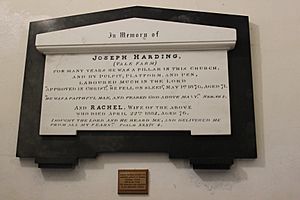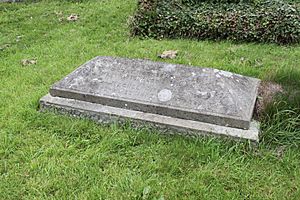Joseph Harding facts for kids
Joseph Harding (born March 22, 1805, in Wanstrow, England – died May 1, 1876, in Marksbury, England) was a very important person in the history of cheese making. He is often called the "father of Cheddar cheese" because he created the first clear steps for making it. Before him, cheese making was more of a guessing game, but Harding made it a science!
He also brought new tools to cheese making. For example, he introduced a "revolving breaker" to cut the cheese curds. This tool saved a lot of hard work. Some people say he invented the cheese mill, but we don't know for sure if that's true. A cheese mill is different from a cheese press, which has been used for hundreds of years.
Contents
Who Was Joseph Harding?
Joseph Harding came from a family of farmers. His parents were Joseph Harding and Mary Yeoman. The Harding family had been farming in England for many generations. Joseph was one of several children. His siblings included:
- Richard Harding, who became a missionary in Jamaica.
- Mary Yeoman Harding, who was known for her kind nature.
- Isaac Harding, who became a missionary in Australia and New Zealand during the time of the gold rush.
Joseph Harding married Rachel Wimboult in 1824. They lived in places like Compton Dando and Marksbury. Rachel also helped him teach others how to make cheese.
People who studied the history of Somerset, England, said that Joseph Harding's cheese-making system became well-known in 1856. They said that Joseph and his wife, Rachel, helped turn cheese making from just "rule of thumb" (doing things by feel) into a clear process. For twenty years, their method was the best way to make cheese.
One of the most important things they taught was how important it was to be super clean. Milk was not brought directly into the dairy from the farmyard. Instead, it was poured into a special container outside the dairy. From there, a pipe carried it inside to the cheese tub. This made sure no dirt from the farm got into the cheese. This focus on cleanliness was a big step forward in food safety!
Making Better Cheese
Joseph Harding found an easy way to remove as much water as possible from the cheese curds. This made Cheddar cheese firm but not crumbly, with a smooth texture. This is the style of Cheddar cheese we know today.
Harding was born into a cheese-making family in 1805. More than anyone else, he helped make Cheddar cheese popular all over the world. He taught people in Scotland how to make it, and he also trained American cheese makers who visited England. His main goal was to make dairy farms cleaner and to create a standard way to make Cheddar.
He famously said, "Cheese is not made in the field, nor in the byre, nor even in the cow, it is made in the dairy." This meant that the most important part of making good cheese happened in the clean dairy, not just with the cows or the farm.
In America, his method of making Cheddar cheese was known as "the Joseph Harding Method."
Harding described good cheese as: "close and firm in texture, yet mellow in character or quality; it is rich with a tendency to melt in the mouth, the flavour full and fine, approaching to that of a hazlenut."
He also believed that using a sharp knife to cut the curds was bad. He thought the curds should be allowed to split naturally.
Harding insisted on controlling the temperature and keeping everything very clean when making cheese. He made sure that milkers could not enter the dairy. Instead, a metal container was placed outside the building. Milk was poured into this, and then it traveled through a pipe into the cheese tub. This pipe had strainers at each end to stop any dirt from the farmyard from getting into the cheese. This was a major step in keeping food safe and clean.
The Joseph Harding Method
The Joseph Harding (or English) Cheddar system was different from older ways of making cheese:
- In the old method, people added sour whey (the watery part of milk) to the milk each day before adding rennet (something that helps milk turn into curds). Harding's method changed how the milk became acidic.
- In the old method, the curds were left to ripen at the bottom of the cheese tub. Harding's method changed this process.
Cheddar Cheese Goes Global
Harding and his wife traveled to Scotland and taught people there how to use modern cheese-making techniques. People from America also visited him to learn his ideas. Because of this, Cheddar cheese is now made all over the world, not just in Somerset, England. He shared his knowledge freely and did not charge for his lessons.
An American dairy expert named Xerxes Willard visited Harding in England in 1866. Willard wrote that Harding "simplified the process of manufacture and helped to reduce it more to a science." After Willard's visit, Cheddar cheese became much more popular and was produced a lot more in the United States.
Joseph Harding's son, Henry Harding, also helped spread Cheddar cheese making to Australia.
Because Harding was so willing to share his knowledge, cheese makers in England later faced a lot of competition from other countries, especially North America, where they could make cheese in large amounts.
Belief in Education
Harding strongly believed in the importance of education. He suggested creating a Dairy College in the West of England. This idea later came true with the establishment of the Somerset Agriculture College.
Images for kids
-
Gravestone of Joseph Harding's sister Mary Yeoman Harding (right) at Stalbridge, Dorset.





